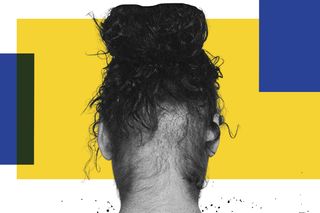
All You Need To Know About Alopecia
The condition develops when the immune system attacks hair follicles, resulting in permanent hair loss.

Hair growth depends on a web of factors: food and nutrition, water intake, gut health, lifestyle — and immune activity. Some things are within our control, some things aren’t; gut health and immunity system fall in the latter category. Alopecia, or permanent hair loss, occurs when an overactive immune system attacks the roots responsible for hair growth.
The scientific phrase for permanent hair loss is ‘alopecia areata,’ a condition common among people who are biologically male and female in which hair falls out in small patches. While it usually affects the scalp, hair fall may also occur in other parts such as eyebrows, eyelashes, and face. Some people experience it slowly over years; for others, hair loss could happen only once in their lives. Common reasons include hormone factors, genetic links, stress, nutrition, and thyroid disease.
While there is no airtight cure for alopecia, several remedies and precautionary measures have been helpful in treating it. They may include natural treatments, such as taking probiotics and vitamins, or medical treatments like injections or oral medication.
What is alopecia?
Alopecia is a common autoimmune disease, which develops when cells that protect bodily functions and immunity mistake healthy tissue for foreign agents. In this case, the healthy tissue is hair follicles, the parts responsible for hair growth, which are misguidedly attacked by the immune system. This results in sporadic and heavy hair loss across all hair-bearing skin. Although hair growth is a continuous phenomenon — in that hair strands grow spontaneously throughout our lives — some skin areas may be damaged over time resulting in a permanent hair loss at that spot. Alopecia areata is, thus, a form of hair loss, but different from hair breakage. In the United States alone, more than 5 million people have recorded cases of alopecia. In India, cases linked to alopecia account for 0.7% of all dermatology cases.
There are different kinds of alopecia:
- alopecia areata refers to coin-sized patches of hair loss on the body, including scalp
- alopecia totalis refers to loss of all hair on the scalp
- alopecia universalis refers to the loss of all hair on the entire body
- androgenic alopecia, also called diffuse alopecia areata, refers to the unexpected thinning of hair all over the scalp and not just in one area
The extent of hair loss and regrowth depends on individual people and their immune health.
Who is at risk of alopecia?
The condition most commonly affects middle-aged men and women, between the ages of 30 and 60 years; there are rare cases among young adults and children. The most common type of alopecia is androgenic alopecia — better known as male and female pattern baldness. Men may experience balding and a receding hairline, while for women, it manifests as general hair thinning or a widening of their part.
Some cases have shown that alopecia is occasionally associated with other autoimmune conditions, such as thyroid disease, type 1 diabetes, rheumatoid arthritis, lupus, and vitiligo. Scientists also say that genes play a role in the development of alopecia areata, as baldness is observed to run within families. External factors such as changes in environment and nutrition often end up being the trigger for alopecia areata in people who are genetically predisposed to it.
Related on The Swaddle:
Lupus: the Immune System Malfunction Science Is Yet to Explain
What are the symptoms of alopecia?
There are two different types of hair shedding: one linked to hair damage and the other linked to decreased hair growth, or alopecia. Hair damage happens because of excessive chemical treatments, such as hair straightening, or mechanically pulling hair too hard in tight braiding or ponytails — but this form of hair loss is common and different from alopecia areata. It does, however, make it difficult to notice patterns in baldness caused because hair has stopped growing.
Common symptoms of alopecia include a receding hairline. For men, hair loss typically occurs at the top and front of their heads. Women may experience hair thinning on the crown of their heads and a broadening of their hair part, but hairlines are relatively unaffected.
Excessive hair loss in the shower, clumps of hair removed when combing, or hair fall on other body parts such as eyelashes, eyebrows, and beards are also signs of alopecia.
Since alopecia is often coupled with other autoimmune conditions, any hair loss coupled with unexplained weight changes, erratic mood swings, and menstrual changes could be a sign of the condition.
What causes alopecia?
Four factors can trigger the overactive immune response behind alopecia. One is linked to hormones and genes: androgenic alopecia, linked to pattern baldness, is often a result of genetic factors that prompt the excess production of a testosterone-derivative called dihydrotestosterone (DHT), which weakens hair follicles. Since women have more estrogen than testosterone (and men have the reverse balance), women tend to have less DHT and therefore less noticeable hair loss.
Other triggers are related to lifestyle changes, including stress, childbirth, medication, physical trauma, and eating disorders. Women are more prone to experience stress-induced alopecia. Men may not notice hair loss due to stress because of a tendency to have shorter hair or a general lack of attention, according to a 2019 study in the journal Clinical, Cosmetic, and Investigational Dermatology.
The thyroid, a gland in the neck that controls metabolism, may be a trigger for alopecia in some cases, which are normally accompanied by menstrual changes and weight fluctuations. Finally, diet and nutrition also have a bearing on triggering alopecia’s excessive immune response: deficiencies such as low vitamin D or anemia could also cause alopecia. However, there is a need for more research into the link between nutritional deficiency and alopecia, according to the American Academy of Dermatology.
Can alopecia be treated or cured?
As an autoimmune disease, the reason for alopecia areata remains elusive, which makes it difficult to develop a lifelong cure. Recent treatments are directed towards slowing down hair loss or coming up with regrowth treatments.
“The condition is difficult to predict, which means it may require a large amount of trial and error until you find something that works for you. For some people, hair loss may still get worse, even with treatment,” according to Heathline.
Natural courses of treatment include dietary changes, herbal and organic supplements, and therapy options such as:
- Probiotics, either in the form of capsules or drinks
- Microneedling, a procedure that involves poking the affected skin area with a small needle
- Taking certain vitamins
- Oiling hair with coconut, castor, or olive oils
- Incorporating aloe vera drinks and topical gels into one’s diet
- Acupuncture
- Taking herbal supplements, such as green tea, ginseng, Chinese hibiscus
Other medications include oral immunosuppressants, like methotrexate and cyclosporine; their usage, however, should be discussed with a doctor, as they are linked to side effects including high blood pressure, liver and kidney damage.
Steroid injections may also be used to help spur hair regrowth on bald spots. The most popular way is to rub steroid ointments or balms on balding parts to decrease inflammation in hair follicles and stimulate hair growth: these include corticosteroid creams such as clobetasol, among other lotions.
Saumya Kalia is an Associate Editor at The Swaddle. Her journalism and writing explore issues of social justice, digital sub-cultures, media ecosystem, literature, and memory as they cut across socio-cultural periods. You can reach her at @Saumya_Kalia.
Related


55% of Covid19 Patients in India Had to Use Connections to Get ICU Beds: Survey
